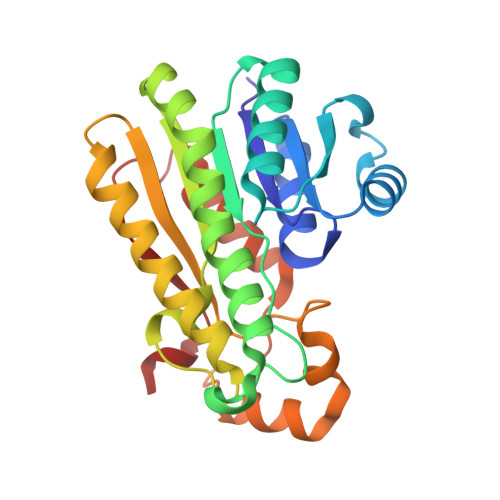Structural Basis for Stereoselectivity in the (R)-and (S)-Hydroxypropylthioethanesulfonate Dehydrogenases.
Krishnakumar, A.M., Nocek, B.P., Clark, D.D., Ensign, S.A., Peters, J.W.(2006) Biochemistry 45: 8831
- PubMed: 16846226
- DOI: https://doi.org/10.1021/bi0603569
- Primary Citation of Related Structures:
2CFC - PubMed Abstract:
Epoxide metabolism in Xanthobacter autotrophicus Py2 results in the conversion of epoxypropane to acetoacetate. Epoxide metabolism is initiated by the nucleophilic addition of coenzyme M to the (R)- and (S)-enantiomers of epoxypropane which forms the respective enantiomers of 2-hydroxypropyl-coenyme M. The (R)- and (S)-enantiomers of 2-hydroxypropyl coenzyme are oxidized to the achiral product 2-ketopropyl-CoM by two stereoselective dehydrogenases. The dehydrogenases catalyzing these reactions, termed (R)-hydroxypropyl-coenzyme M dehydrogenase (R-HPCDH) and (S)-hydroxypropyl-coenzyme M dehydrogenase (S-HPCDH), are NAD(+)-dependent enzymes belonging to the short chain dehydrogenase/reductase (SDR) family of enzymes. In this study, the crystal structure of R-HPCDH cocrystallized in the presence of (S)-hydroxypropyl-coenzyme M has been determined using X-ray diffraction methods and refined to 1.8 A resolution. The structure of R-HPCDH is tetrameric and stabilized by the interaction of the terminal carboxylates of each subunit with divalent metal ions. The structure of the presumed product-bound state reveals that binding interactions between the negatively charged oxygen atoms of the sulfonate moiety have striking similarities to sulfonate interactions observed in the previously determined structure of 2-ketopropyl-CoM oxidoreductase/carboxylase, highlighting the utility of coenzyme M as a carrier molecule in the pathway. The key elements of the aforementioned interactions are electrostatic interactions between the sulfonate oxygen atoms and two arginine residues (R152 and R196) of R-HPCDH. The comparison of the structure of R-HPCDH with a homology model of S-HPCDH provides a structural basis for a mechanism of substrate specificity in which the binding of the substrate sulfonate moiety at distinct sites on each stereoselective enzyme directs the orientation of the appropriate substrate enantiomer for hydride abstraction.
- Department of Chemistry and Biochemistry, Montana State University, Bozeman, Montana 59717, USA.
Organizational Affiliation:


















